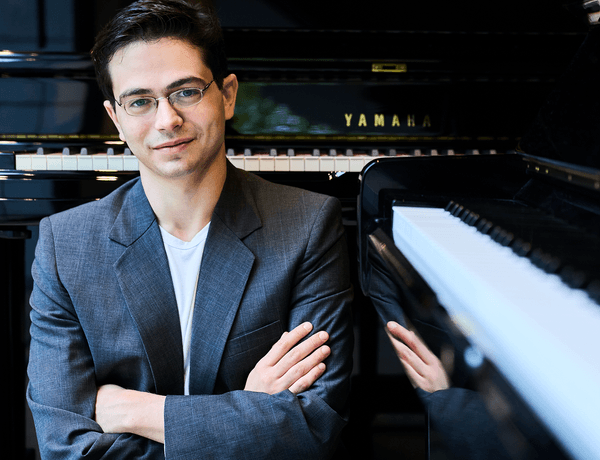Mendelssohn's Italian Symphony

Full programme
- Farrenc, Overture No.2 (7mins)
- Mozart, Piano Concerto No.25 (30mins)
- Schubert, Overture in the Italian Style in D major (7mins)
- Mendelssohn, Symphony No.4 (Italian) (27mins)
Performers

Olari Elts
Conductor
Ariel Lanyi
Piano
Introduction
Welcome to an afternoon of summer sunshine in the Symphony Hall, plus the magic of Mozart.
Mozart's Piano Concerto No.25 in C major is radically different from his other two piano concertos dating from the year 1786, especially from the fiery and tragic C minor concerto. The other two are, to a certain degree, introspective, whereas the concerto K. 503 begins and ends on a note of exuberance and nobility.
This latter quality is heard in all three movements: the two main themes of the first movement exude a sense of constancy, and the Andante is one of the noblest movements of the piano concerto repertoire. But of course, it wouldn’t be a Mozart concerto were its celebratory and grand nature not coupled with his inimitable sense of humour. Indeed, the entrance of the piano in the first movement attests to that - we expect the piano to enter with a statement, but instead, Mozart merely gives us snippets of a statement, which then develops into an almost improvisatory episode.
A particular fascination of mine has always been the way in which great composers achieve variety and unity within a work. One way in which Mozart achieves that in this concerto is with the repeated note motif, which we hear at the very beginning of the first movement. This ever so simple musical unit is taken by Mozart on a journey across the whole expressive and emotional spectrum. In the beginning of the first movement, it is persistent and maybe even stubborn; in the second theme, it suddenly becomes lyrical and tender. And in the other two movements, it subtly reminds us of its existence when we least expect to hear it.
Ariel Lanyi
Piano
Programme notes
Felix Mendelssohn loved Birmingham – but his travels didn’t stop here, and when he visited Italy for the first time his heart leaped for joy. His sun-kissed ‘Italian’ symphony is the exuberant climax to a whole afternoon of genius off the leash: whether Mozart’s majestic piano concerto, or the windswept energy of the composer they called the “female Beethoven”: Louise Farrenc.
Overture No.2, Op.24
Louise Farrenc (1804-1875)
There was little that Louise Farrenc couldn’t do in the field of music. At a time and place – France in the first half of the nineteenth century – where women struggled to be taken seriously as professional musicians, she was appointed professor of piano at the Paris Conservatoire, a post she held for three decades. Even more remarkably, she demanded (and eventually received) the same pay as her male colleagues. Her piano and chamber compositions were widely admired but only in 1834 did she turn to orchestral music, with a pair of superb concert overtures. She would go on to write three full-scale symphonies.
That was easier said than done in Paris during the 1830s. Musical life centred on the salon and the opera house, and adequate performances of orchestral music were rare. Which makes Farrenc’s overtures even more remarkable. In the second, she takes a large (for the time) orchestra and strides out with a grand and tragic slow introduction, before unleashing a bracing summer storm (the violins provide the first swirls), lightened by chattering, conversational woodwinds. There’s definitely a story being told - even if Farrenc preferred to let her music do the talking.
Piano Concerto No.25 in C major, K.503
Wolfgang Amadeus Mozart (1756-1791)
I. Allegro maestoso
II. Andante
III. Allegretto
Mozart wrote some of the most wonderful letters of any creative artist – brimming with wit, joy and good old-fashioned gossip. But he almost never discussed the business of writing music, and there are whole periods of his life about which we know almost nothing. Perhaps those dark patches wouldn’t seem quite so dark if the masterpieces that emerged from them didn’t shine quite so brilliantly. And for a textbook demonstration of musical brilliance, as understood in the late 18th century, listen to the majestic opening of his Piano Concerto No.25, completed in Vienna on or just before 4th December 1786.
The key is C major, in which 18th century brass instruments sound particularly dazzling. Mozart deploys trumpets (coupled with their traditional partner, timpani) as well as oboes and a flute to give the grand, ceremonial rhythms of the opening bars the brightest possible colour. This is a concerto designed to make a big impression in public, and it’s generally assumed that it was created for one of a series of concerts that he proposed to give at the Trattnerhof Casino, though whether or not these concerts ever happened remains a subject of dispute.
Beyond that, we don’t know much. So it’s probably easiest to let the music speak for itself: the conversational woodwind asides that quickly begin to undercut the grandeur of that opening; the way the wind instruments gently take the reins of the melody in the Andante, and the smiling, civilised unfolding of the finale, where Mozart uses the full ceremonial brilliance of his orchestra only as punctuation. This is Mozart playing with his audience’s expectations – teasing them, amusing them, and letting them enjoy his genius at its untrammelled, irresistible height. For Mozart, piano concertos were always a two-way conversation with his Viennese public: 238 years later, we get to listen in.
Overture in D “in the Italian style”
Franz Schubert (1797-1828)
Nothing succeeds like success: and in Vienna in 1817, nothing was more successful than the operas of the Italian composer Gioacchino Rossini. Local composers were understandably irritated (only Beethoven was big enough to rise above the craze), and one story about Schubert has him attending a performance of Rossini’s opera Tancredi with some musical friends. They went wild about the overture, in particular: until, according to Schubert’s early biographer Heinrich von Kreissle,
"Schubert had heard enough and declared that he could easily write an overture in exactly the same style, just like that. His companions took him at his word and vowed to buy him a glass of wine if he did. Schubert set to work immediately…"
It’s a cracking story. Is it true? H’m. What’s definitely true is that this overture, composed in December 1817, is in an Italian (ie Rossini’s) style – a long, stately introduction followed by a lively, bustling main section with big dramatic crescendos and lots and lots of fresh, memorable melodies. They’re unmistakably Schubert’s melodies, though. Still, ask any foodie: if you want the best Italian cooking outside of Italy, you go to Vienna.
Symphony No.4 in A major, Op.90 (Italian)
Felix Mendelssohn-Bartholdy (1809-1847)
I. Allegro vivace
II. Andante con moto
III. Con moto moderato
IV. Saltarello: Presto
Felix Mendelssohn first travelled to Italy in the autumn of 1830, at the age of 21, and he drank it all in: the music, the landscape, the art and the night air itself. “This is a truly glorious life!” he wrote from his room in Rome (No.5., Piazza di Spagna) to his father, back home in a wintry Berlin:
When I come into the room early in the morning and see the sun shining so brightly on my breakfast (you see, I could have been a poet) I immediately feel utterly contented; for it is now late autumn and who back home can still expect warmth or a blue sky, or grapes and flowers? After breakfast I begin my work, and play and sing and compose until noon. Then all of Rome lies before me, ready to enjoy…
He calls it work – but for someone who expressed himself through music as naturally as Mendelssohn did, it was only a matter of time before Italy started to work its magic on his creativity. Shortly before he left Rome for Naples, in March 1831, he reported that:
I have begun to compose with fresh vigour, and the Italian symphony makes rapid progress; it will be the most amusing piece I have yet composed especially the last movement.
Mendelssohn was a perfectionist. It would be March 1833, back in Berlin, before he finished polishing it for a performance in London (where it was premiered on 13th May that year), and he continued to revise the symphony for months afterwards. It was never published in his lifetime. But by some miracle, the Italian symphony still managed to catch, on the wing, that first, fresh sunburst of colour, delight and youthful excitement: as Mendelssohn put it, “the most wonderful combination of gaiety and seriousness”. “My family will have told you of the exhilarating impression made on me by the first sight of the plains of Italy”, he wrote to his friend Zelter, and we can hear it too. The whole first movement has a dance-like energy and verve.
The symphony’s inner movements are gentler in tone: perhaps Mendelssohn could have been a poet after all? He was certainly a gifted watercolourist, and in the Andante con moto he uses muted orchestral shades and chant-like melodies to evoke a solemn procession amid the shadows of one of Rome’s great baroque churches (Mendelssohn ticked them all off his sightseer’s list). Next comes a lilting minuet, Con molto moderato. The horns blush like the evening sun.
And then, with a sudden snap and a pounding rhythm, we’re into the finale. It’s a saltarello – a flying, whirling Italian dance from Naples (the next stop on Mendelssohn’s tour, though he seems to have drafted the music in Rome). The energy is irresistible. Mendelssohn – a great maker of friends – enjoyed mixing with the colony of young French artists resident at the Villa Medici, where he saw the seventeen-year Louise Vernet dancing the saltarello with a tambourine in her hands. “What a superb picture she would have made!” he noted, before painting exactly that picture in the finale of his symphony.
© Richard Bratby
Featured image © Kaupo Kikkas